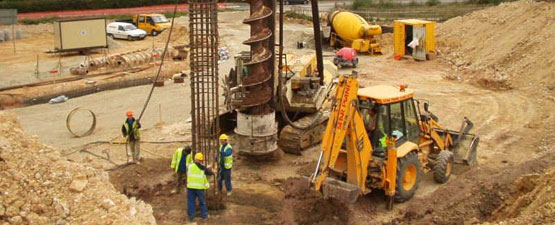Professional Civil Geotechnical Engineering Solutions for Complicated Projects
Professional Civil Geotechnical Engineering Solutions for Complicated Projects
Blog Article
Exactly How Consulting Engineers Enhance Geotechnical Engineering Projects: Insights Into Their Know-how, Techniques, and Collaborative Approaches
Consulting engineers are pivotal in improving geotechnical engineering jobs, using their specialized knowledge to navigate the complexities of subsurface conditions. Their approaches incorporate a variety of website investigation techniques, consisting of Requirement Infiltration Examinations (SPT) and Cone Penetration Examinations (CPT), which inform critical choices during the design and building and construction phases. Their collaborative techniques foster communication among varied project stakeholders, inevitably shaping the project's trajectory. As we take a look at the multifaceted duties these professionals play, it ends up being clear that their contributions prolong past technical know-how, motivating a closer consider the implications for job success.
Function of Consulting Engineers
The expertise of seeking advice from designers in geotechnical design is basic to the effective execution of building jobs. These specialists play a critical role in examining dirt and rock homes, which are important variables influencing layout and building and construction choices. By carrying out complete website examinations, getting in touch with engineers collect important data that notifies the style process, guaranteeing jobs are built on secure and ideal ground.
Consulting engineers also offer vital understandings into danger management (geotechnical geologist). They identify potential geotechnical hazards, such as landslides, soil liquefaction, and negotiation problems, allowing stakeholders to execute effective mitigation strategies. Their proficiency help in maximizing structure styles, which can result in significant price financial savings and improved safety
Furthermore, consulting designers offer as an important link in between job owners, engineers, and service providers. Their capacity to equate complex geotechnical information into workable recommendations fosters cooperation and helps with educated decision-making throughout the project lifecycle. This multidisciplinary technique not only improves task effectiveness but additionally makes sure conformity with regulatory requirements and ideal methods.
Trick Methods in Geotechnical Engineering

One primary approach is site investigation, which involves conducting area tests and lab analyses to collect information on subsurface problems. Methods such as Requirement Infiltration Screening (SPT) and Cone Infiltration Screening (CPT) are extensively used to assess soil stratigraphy and strength. In addition, geophysical methods, including seismic and electric resistivity studies, offer non-invasive methods to examine subsurface characteristics.
Another crucial approach is mathematical modeling, which allows engineers to simulate numerous situations and predict how soil-structure interactions will act under different loading conditions. Limited Aspect Analysis (FEA) is a common approach used in this context.
In addition, the layout of structures, maintaining structures, and earthworks relies greatly on these techniques - geotechnical geologist. By incorporating sophisticated analytical tools with field information, getting in touch with designers can develop tailored remedies that resolve particular job difficulties, ultimately adding to the security and security of construction tasks
Importance of Dirt Analysis
Soil evaluation serves as a fundamental element in geotechnical design, offering important understandings into the physical and chemical homes of dirt required for effective construction preparation. Understanding soil characteristics is vital for identifying its load-bearing ability, drainage habits, and potential for settlement or instability. Thorough soil investigations, including tasting and laboratory screening, help identify specifications such as soil type, wetness content, density, and shear stamina.
These evaluations inform the option of ideal construction techniques and products, ultimately influencing job safety and security and longevity. Cohesive soils may need different foundation styles contrasted to granular dirts, necessitating customized engineering services. Soil evaluation help in determining pollutants that could position risks to human health or the environment, permitting for the advancement of mitigation techniques.
Incorporating soil evaluation right into the beginning of project development helps to decrease unpredicted obstacles, making certain that designers can expect and deal with potential concerns prior to they intensify. By establishing a comprehensive understanding of the website problems, seeking advice from engineers can optimize layout effectiveness and decrease costs, therefore improving the general success of geotechnical engineering tasks.
Collective Methods in Tasks
Effective geotechnical projects typically depend upon collaborative techniques that bring together diverse know-how from various techniques. Efficient collaboration amongst speaking with designers, geologists, ecological scientists, and building and construction experts is crucial for resolving complex obstacles and optimizing task outcomes. By leveraging the one-of-a-kind skills and expertise of each team participant, projects can take YOURURL.com advantage of an i thought about this all natural understanding of the site problems, regulatory demands, and design constraints.
Normal communication and interdisciplinary meetings promote the sharing of understandings and cultivate a society of teamwork. These collective efforts allow the recognition of possible threats early in the project lifecycle, permitting timely reduction techniques. In addition, integrating feedback from stakeholders, including regional communities and governing agencies, ensures that all viewpoints are taken into consideration, improving job acceptance and compliance.
Additionally, the integration of sophisticated innovations, such as Geographic Info Solution (GIS) and Building Information Modeling (BIM), further enhances collaboration. These tools permit the real-time sharing of data and visualization of geotechnical conditions, advertising educated decision-making. Inevitably, a joint approach not just simplifies task implementation yet likewise lays the foundation for cutting-edge remedies to intricate geotechnical engineering obstacles.
Influence On Job Outcomes

Consulting designers use sophisticated techniques such as danger evaluation and anticipating modeling, which enhance the precision of job projections. Their capability to incorporate innovative innovations, like geotechnical instrumentation and data analytics, even more improves the design and building and construction processes. Consequently, tasks experience enhanced effectiveness, lowered costs, and lessened hold-ups.
Moreover, fostering efficient interaction and partnership among staff member enhances problem-solving abilities. When challenges occur, an unified front enables swift identification of options, protecting against potential problems. Eventually, the collective initiatives of consulting engineers add to higher top quality outcomes, making sure that tasks fulfill both regulatory standards and client expectations.
Conclusion

Report this page